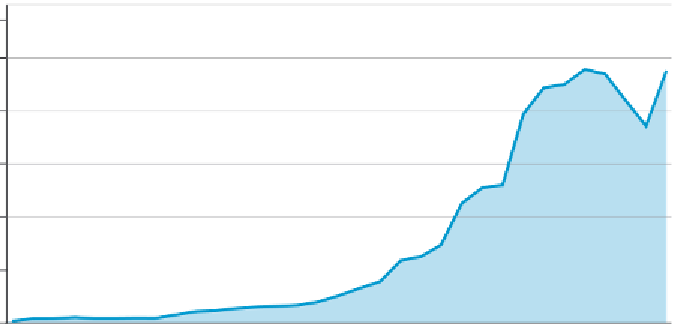Environmental Engineering Reference
In-Depth Information
FIGURE 4.10
Increase of Production Rate over Mine
Life Illustrated
300
250
From an initial production rate of
less than 20,000 tons per day of
ore in early 1970, Freeport's mining
operations in the Papua Province of
Indonesia now extract copper and
gold bearing ore at a staggering rate of
more than 250,000 tons per day, which
equates to more than 90 million tons
each year. In comparison, most
mid-sized gold mines process about
1 million tons of ore per year.
200
150
100
50
0
faster to achieve. Secondly, exploration continues during the mine operation and addi-
tional mineable ore reserves may be discovered. For the purpose of environmental permits,
it is often advisable to obtain the permit for a realistic but upper limit of ore production
rates. The environmental permit remains valid if actual ore production rates are below the
approved ore production rate; a new environmental approval however may be required if
actual rates signii cantly exceed the approved design rate.
Ore production rates largely depend on the mining method employed. The depth of
a particular deposit determines whether it will be extracted by surface mining, in which
minerals or coal are extracted directly at the surface, or underground mining, in which
deposits are too deep to be economically removed by surface mining (
Figure 4.11
)
. Surface
mining is more common, since it is less expensive than underground mining. Hence, only
high ore grades normally warrant underground mining.
At this point some semantic difi culties relating to the size of a mine operation need to
be examined. Depending on the point of view, various means of referring to the size of
operations are common, as illustrated in
Table 4.3
for a hypothetical copper mine opera-
tion. For example, the mine superintendent thinks in terms of material moved, while the
mill superintendent cares about the amount of ore processed per day. Top management
thinks in terms of copper equivalent per year. The i gures in
Table 4.3
are based on a mine
producing 100,000 tons of copper per year from copper ore with an average grade of 0.5
percentage, and with an average stripping ratio 2 to 1. In most circumstances, however,
mine size is expressed as tons per day of processed ore.
A new environmental approval
may be required if actual rates
signifi cantly exceed the approved
design rate.
In most circumstances mine size
is expressed as tons per day of
processed ore.
Benefi ciation
Excavating ore from the Earth is only half the battle since the required products are rarely
found in their pure form. More often they are mixed with rock and gangue minerals, and
usually as compounds of several elements. Some minerals yield their elemental constituents
more readily than others. Therefore the economic viability of an ore deposit depends not
only on the quantity and quality of accessible ores, but also on the ease with which valuable
metals can be extracted from gangue materials (schematically illustrated in
Figure 4.12
for
pyro-metallurgical copper extraction). Mineral extraction from ore conventionally takes
place in mills (ore dressing or benei ciation), smelters (converting concentrates to metals),
and rei neries (producing the i nal high grade products as required by the market).
Ore benei ciation is the processing of ores to regulate the size of the product, to remove
unwanted constituents, or to improve the quality, purity, or grade of a desired product.











Search WWH ::

Custom Search